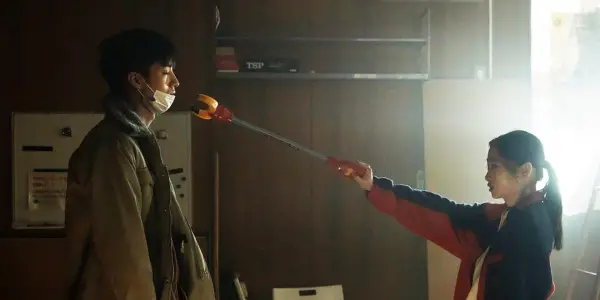Japan is far from new to both the thriller and horror genres, receiving much of its recognition for the release of J-horror classics like Ju-on: The Grudge, Pulse, Audition, and Ringu. Finding strength in its strong ability to create tension and delve into thematic depths, J-horrors are an undeniable force within their genre. Debuting at this year’s Fantastic Fest, Shinzô Katayama‘s Missing retains the feeling of a J-horror, slowly building the intensity of its mystery while examining the potential compassion and deliverance of death. And while it strives to reach the level of its predecessors, some viewers will find there is just something… missing.
A Mystery of Horror in Three Parts
Missing is quick to introduce the confusion that will be at the core of its intensity building, a man framed by a doorway as he wields a hammer. Whether it is in preparation or practice, the audience is given little more to the moment, transitioning to a young girl running through the streets of Osaka. As we see the worry in her eyes, the confusion parallels the opening, the audience unsure whether she is running from or to someone. We learn shortly after however, that she is running to help her father, who has been caught shoplifting. She is able to help her father avoid the authorities, yet unable to help him avoid the troubles that ail him. As they make their way home and through the evening, the tumultuous introduction of the father and daughter smooths out, revealing a deeply connected pair that not only offers support and comfort but has an innate understanding of one another.

This reads equally true when Kaede (Aoi Itô) wakes the next morning to find her father gone. We have been given little to nothing to go on regarding their daily routine, yet we understand that Kaede instantly knows something is off. As the day continues, Kaede becomes more and more concerned about her father’s whereabouts, her subsequent search filling the first third of the film. There is this innate sense of knowing something is wrong, that something is off. The relationship developed between father and daughter is established quickly and deeply, giving authenticity to the story to follow. Yet, what is lacking in this first third is a sense of urgency. It never truly feels as though we as an audience are led to believe that Santoshi (Jirô Satô) may be in trouble, that something may have happened to him. We believe the daughter, and we understand her deeply rooted belief that something terrible has happened, but we never share in her need to find him. No true threat is realized for the audience to attach to.
Yet, this is not just a story about a missing father, the film reveals itself to be a three-part narrative story, where each section welcomes the audience into a darkening truth and a terrifying horror. As the film enters into its second and third acts, there is a genuine intrigue that is formed. This comes from both the performances, but also from the unpredictable direction the film diverts into. And if you find yourself confused, then Missing is succeeding in its intricately crafted narrative and forms of misdirection. If you find yourself confused, know the payoff is going to be worth it.
Focusing on the Strength
While Missing may struggle with its opening intensity, threatening for a time to lose its audience, it is not all lost. Exquisite close-up shots and sequences, the biting of an orange, in particular, will deliver audiences an existential feeling outside of the film. There is a delicacy and delicate nature to these shots, savoring the time spent and craftsmanship behind them. They also play into the metaphor of life, the little things to be seen and appreciated – especially in times of darkness. The beauty within a horror. These moments are standouts in the film, a feature you may find yourself yearning more of. Yet, where these moments come and go in Missing, it is the performances that truly carry the film.
Missing finds its strength in the performances of its leading men in particular. Hiroya Shimizu shines as “No Name” Yamauchi. His balance between compassionate pitches to the sinister smile that spreads across his face crafts each moment into calculated perfection. Shimizu delivers authenticity with a devilish nature hidden under a mask of sincerity and compassion. He contains the most chilling of moments – without even saying a word.
And where Shimizu delivers the chills in his Yamauchi, Jirô Satô contains the heartbreak and pain. His Santoshi is a true stand-out, his performance reaching beyond the expected fear within a horror film, allowing Santoshi to feel the painstaking horrors of real life. There is terror that lives within his Santoshi, one that not only fuels his actions but truly elevates the character to a deeper journey of horror. Satô encompasses not only this journey but becomes an example of how we can all become lost.
Conclusion:
Unfortunately, Missing can easily become a debatable film about when to end. It feels almost as if the film concludes, through deviant yet satisfying means, yet never truly knows where to stop. Missing embarrasses the longer version, absorbing its epilogue into its narrative to give the film a full circle feeling we didn’t know we were still in need of. For some, this extension will be the most satisfying, while for others, an overdrawn conclusion. In essence, Missing becomes the paradox of two alternate endings within one film, all while still retaining its sense of mystery and craftsmanship.
Missing premiered at the 2022 Fantastic Fest on September 22, 2022.
Watch Missing
Does content like this matter to you?
Become a Member and support film journalism. Unlock access to all of Film Inquiry`s great articles. Join a community of like-minded readers who are passionate about cinema - get access to our private members Network, give back to independent filmmakers, and more.